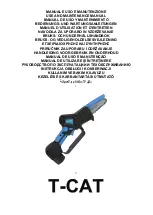
4
5.2 Mains connection
Mains connection and any extension
cords used must comply with
applicable regulations.
The mains voltage must comply with
the information on the machine
licence plate.
The mains connection must have a 16
A surge-proof fuse.
Only use power cords marked
H07RN-F
Connections and repairs to the
electrical equipment may only be
carried out by qualified electricians.
5.3 Dust connection
Before initial operation, the machine
must be connected to a dust extractor.
The suction should switch on
automatically when the bandsaw is
switched on.
The flow rate on the suction port must
be 20m/sec.
Flexible hoses must be of non-
flammable quality, and must be
connected to the machine ground
system.
5.4 Starting operation
You can start the machine with the
green on button. The red button on the
main switch stops the machine.
6. Machine operation
Correct working position:
In front of the machine standing in the
direction of cutting.
Workpiece handling:
Hands placed flat on the workpiece
outside the cutting area.
Feed the workpiece towards the saw
blade in the direction of the saw line,
and cut as required by turning to
follow the line drawn. Push the
workpiece steadily forward; complete
the cut as a single movement. Do not
draw the workpiece back, as this
could cause the sawblade to run off its
wheels.
Support long and wide workpieces
with helping roller stands.
Operating hints:
Work only with a sharp and flawless
sawblade.
Near the cutting area use a push stick
to feed.
Bring the upper blade guide to a
distance of approx 0,5 cm to the
workpiece.
Use a feeding template to safely guide
small and narrow workpieces.
Use a suitable wedge to prevent round
timber from turning under the
pressure of the cut
Blade Drift:
Blade drift is a frequent problem on rip
cuts and during resawing.
Blade drift may occur when the fence
is being used, the blade begins to
wander off the cutting line (Fig 5).
.
Fig 5
Blade drift can be caused by a
number of factors.
- The saw blade follows the grain
- The saw blade is dull.
- Blade guides not adjusted correctly.
- Blade tension unsufficient.
- Blade-teeth have asymmetric“set”
Resaw guide:
The resaw guide allows you to
compensate blade drift.
The feed direction can be lined up to
follow the cut.
For resawing attach the post (A, Fig 6)
to the fence with the lock knob (B).
Position the post so that it is centered
with the blade teeth.
Fig 6
Mitre gauge:
Place the mitre gauge in the table
T-slot.
If the mitre gauge is not square loosen
the lock knob (C) and adjust the
pointer (D).
For the authorized use of the
machine observe the appendix A
“safe operation“
(on the last pages of this operating
manual)
A.1: Performing high cuts
A.2.: Performing diagonal cuts
A.3.: Tenon cutting
A.4.: Cutting of wedges
A.5.: Curved cuts
A.6.: Arc cuts
A.7.: Cutting with template
A.8.: Circular cutting
A8.1 Set up without workpiece
A8.2 Placing the workpiece
A8.3 Machining
7. Setup and adjustments
General note:
Setup and adjustment work may
only be carried out after the
machine is protected against
accidental starting by pulling the
mains plug.
7.1 Changing the sawblade
The sawblade has to meet the
technical specification.
Choose a suitable sawblade,
according to the cutting operation and
according to the material to be cut.
For high rip cuts:
- use a wide sawblade (e.g. 16mm),
coarse teethed.
For narrow curved cuts:
- use a narrow sawblade (e.g. 3mm).
Check sawblade for flaws (cracks,
broken teeth, bending) before
installation. Do not use faulty
sawblades.
The sawblade teeth must point in
cutting direction (down)
Always wear suitable gloves when
handling sawblades.







































